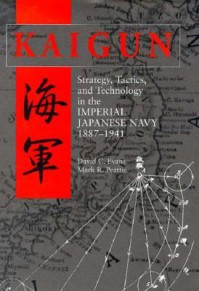A groundbreaking history of the Imperial Japanese Navy

When it comes to history books, there are good ones and there are great ones. And then there are a few that are truly groundbreaking in their ability to take a subject that has been studied before and address it with such insight that it changes fundamentally the way we think about it. This is one of those books. For in describing the development of the Imperial Japanese Navy from the late 19th century to the attack on Pearl Harbor David Evans and Mark Peattie offers readers a revolutionary look at the thinking and planning that defined the shape of the Pacific War (as the war against the United States and the European imperial powers is called in Japan) before its first shot was ever fired.
Perhaps one of the most surprising things about the Imperial Japanese Navy is how relatively late it was established, for in spite of being an island nation Japan had no naval arm. This changed after the Meiji Restoration, as Japan began to look outward for the first time in centuries. Quickly appreciating the importance of naval arms to national power, the Japanese created a naval force tasked with protecting its shores. Turning to the British the Japanese not only brought over advisers from there to train their officers but purchased many of its first vessels from its shipbuilders — a necessary step given the undeveloped state of Japanese industry at that time.
By the 1890s the Japanese possessed a small but respectable force, yet the navy still was junior to the army in both status and planning. This changed with Japan's wars of expansion, first with China in 1894-5, then with Russia ten years later. It was then that the Imperial Japanese Navy shifted from a coastal-defense role to one designed to project Japanese power in accordance with the dominant Western strategic thinking of that time. Japan's navy impressed observers with their performance in these two wars, especially with their defeat of the Russians. Here Evans and Peattie stress the importance of the battle of Tsushima both in establishing the navy's reputation and in defining its subsequent thinking. The clash was decisive in ending Russia's hopes for victory in the Russo-Japanese War, and — even more significantly — cemented the idea of the kantai kessen, or decisive battle, in Japanese naval thinking, which would define both the development of the IJN for the remainder of its existence and its conduct of the war against the United States forty years later.
This path was set virtually from the start. For the first decades of its existence Japanese naval strategists regarded regional powers — first China, then Russia — as their most likely opponents. Having defeated both countries, and with an alliance with Great Britain securely in place the United States now became the most likely opponent in a future war. Japan's response to international trends, from the arms races of the 1910s to the arms control treaties of the 1920s were shaped by this, as were ideas about warship design. This did not necessarily have to lead to war, but as Japan contemplated further expansion of its empire it always did so with an eye towards a possible challenge from the Americans, and prepared accordingly.
The result was a fleet designed to defeat the United States Navy in accordance with kantai kessen. Accepting that the United States would possess an unavoidable numerical advantage, the Japanese emphasized quality in naval design and the development of weapons such as the "Long Lance" torpedo and tactics such as night-time fighting that would offset the Americans' superior numbers. These were tested in maneuvers that sometimes cost lives, but resulted in a force which was ready to implement doctrine in practice when war came. The opportunity arose first in China in 1937; here Evans and Peattie stress the often underappreciated advantage four years of combat experience gave the IJN at the start of their conflict with the United States -- experience which the United States would offset only after months of bloody lessons in the South Pacific in 1942 and 1943.
Evans and Peattie conclude their book with a short chapter summarizing the impact of this development on Japan's conduct of the Pacific War. Yet the relative brevity of this section understates the value of this book for readers interested in the Japanese Navy's performance in the Second World War. This is by far the single best book in English on the history of the Imperial Japanese Navy, one that is likely to remain the definitive text on the subject and necessary reading for anyone who wants to learn about Japanese military history or the development of naval combat in the Pacific during the war.






